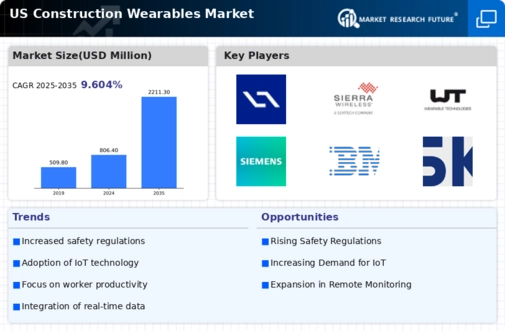Regulatory Compliance and Standards
Regulatory compliance and standards are increasingly shaping the construction wearables market. In the United States, regulatory bodies are establishing guidelines that encourage the adoption of wearable technologies to enhance worker safety. Compliance with these regulations not only helps companies avoid penalties but also promotes a safer working environment. The construction wearables market is likely to benefit from this trend, as firms seek to align their operations with evolving standards. As regulations become more stringent, the demand for wearables that facilitate compliance is expected to rise, driving innovation and investment in this sector.
Growing Emphasis on Health Monitoring
The construction wearables market is witnessing a growing emphasis on health monitoring solutions. With the rise of wearable technology, devices that track vital signs, fatigue levels, and overall health are becoming integral to construction sites. This trend is particularly relevant in the United States, where the Occupational Safety and Health Administration (OSHA) has highlighted the importance of monitoring worker health to prevent accidents. The market for health-focused wearables is expected to grow significantly, as companies recognize the potential to reduce workplace injuries and enhance employee well-being. By investing in health monitoring wearables, construction firms can not only comply with regulations but also foster a culture of safety and care.
Increased Investment in Safety Training
Increased investment in safety training is a key driver for the construction wearables market. As companies allocate more resources to training programs, the integration of wearables into these initiatives is becoming more common. Wearable devices can provide real-time feedback during training sessions, enhancing the learning experience and ensuring that safety protocols are followed. In the United States, the construction industry is projected to spend over $1 billion annually on safety training, which is likely to boost the adoption of wearables. This trend indicates a shift towards a more proactive approach to safety, where technology plays a crucial role in educating workers and minimizing risks on-site.
Rising Demand for Enhanced Productivity
The construction wearables market is experiencing a notable surge in demand driven by the industry's need for enhanced productivity. As construction projects become increasingly complex, the integration of wearables such as smart helmets and exoskeletons is seen as a viable solution to improve efficiency. Reports indicate that companies utilizing these technologies can achieve productivity gains of up to 30%. This trend is particularly pronounced in the United States, where labor shortages and project delays have prompted firms to seek innovative solutions. The construction wearables market is thus positioned to benefit from this growing emphasis on productivity, as stakeholders recognize the potential for wearables to streamline operations and reduce costs.
Technological Advancements in Wearable Devices
Technological advancements are significantly influencing the construction wearables market. Innovations in sensors, connectivity, and data analytics are enabling the development of more sophisticated wearable devices. For instance, the introduction of real-time monitoring systems allows for immediate feedback on worker health and safety, which is crucial in high-risk environments. The market is projected to grow at a CAGR of approximately 25% over the next five years, reflecting the increasing adoption of these advanced technologies. As construction companies in the United States continue to invest in cutting-edge wearables, the market is likely to expand, driven by the demand for improved safety and operational efficiency.
























Leave a Comment